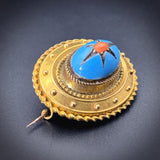The Grand Tour was a rite of passage starting in the late 17th Century. It continued for about 300 years, tapering off into obscurity around the turn of the 20th Century. A typical "Grand Tourist" would be an educated and wealthy Englishman, German, Scandinavian, or American. The trip was a method of architectural, cultural and social study. The itinerary could vary, but usually a Tour started in France and ended in Italy. The Castellani brothers were pioneers in sourcing the techniques to replicate the look of ancient jewelry found in Rome and other archeological digs in Italy. The Etruscan Revival style became wildly popular and the technique was utilized in most of the jewelry during the latter part of the Victorian Era.
This brooch is a great example of archeological revival from the 19th century. A bright turquoise blue enameled dome displays a starburst motif punctuated with an orange coral cabochon. Framed in 12 karat yellow gold, it has distinct characteristics of the Etruscan Revival style, and creates a marvelously color contrasting look overall. It has a locket back, which probably held a lock of hair at one time, but may now be filled as you wish. An eye-catching piece that any Victorian jewelry collector needs in their collection!
Details (approximate)
Dimensions: 1 3/8"
Weight: 10 grams
Materials: Gold, Coral, Enamel, Glass
Metal: 12K yellow gold
Marks: None
Condition: Excellent Antique Condition
LOTLJ









